
FODMers Study Summer Plants
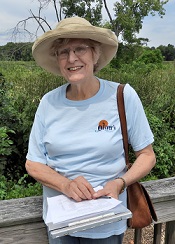
On August 10, 2019, Dr. Elizabeth Wells, botanist, led a plant walk in Dyke Marsh. The 20 attendees learned about many native insects and plants during the three-hour walk along the Haul Road trail and out to the end of the boardwalk.
Storm Felled Iconic Tree
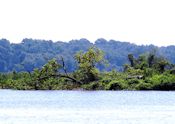
On July 17, 2019, during an early evening storm, the beautiful Eastern cottonwood tree on Dyke Island, came down. “This tree was one of the most loved bald eagle perches in the George Washington Memorial Parkway park,” said Brent Steury, National Park Service Natural Resources Program manager for the Parkway. FODMers have also seen peregrine falcons, Baltimore orioles and other birds using the tree to rest and nest.
Pileated Woodpeckers Are Active in Dyke Marsh

In June 2019, FODMers observed pileated woodpeckers in Dyke Marsh feeding young, corroboration of successful nesting, and observers saw a male pileated feeding grubs to a fledgling male that appeared larger than his parent. After that, the young pileated moved and surveyed a branch in a cottonwood tree that had an abundance of carpenter ants. He feasted on his prey, using his long sticky tongue to access them.
Turk's Cap Lilies Brighten the Wetland

On July 2, 2019, FODMer Ed Eder photographed Turk’s cap lilies (Lilium superbum) while canoeing in the southern big gut of Dyke Marsh. Ed commented that a few clusters remain, having “survived despite profound erosion. How long they will hang on is difficult to ascertain, but the Lilium superbum is a gem in any wetland and difficult to locate at all in Fairfax County.”
Sea Level Rise Will Affect Dyke Marsh
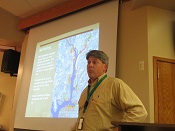
The rate of relative sea level rise along the tidal Potomac River is around 3.33 millimeters a year according to long-term water level data collected by the National Oceanic and Atmospheric Administration (NOAA), reported Geoffrey Sanders on May 15, 2019, to 65 people who attended FODM’s quarterly meeting. Sanders is the Network Program Manager for the National Park Service’s National Capital Region Inventory and Monitoring Network.
Dueling Flickers
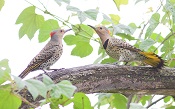
Ritual combat is often used among birds to settle disputes over territories or mate selection. Most of the time the postures assumed appear threatening but avoid serious contact or injury. Northern flickers (Colaptes auratus) are known for their elaborate ritual flights which involve tail flashing, bill pointing and circling as well as lunges and chase flights. Both sexes participate in ritual combat and the presence of an observer of the opposite sex intensifies the aggression, which may last for hours, with pauses.
Moving in on Mile-a-Minute
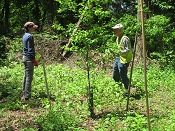
On May 6, 2019, 10 FODMers worked hard to remove and control the aggressive plant, mile-a-minute (Persicaria perfoliata), in the native plant area along the Haul Road trail in Dyke Marsh. The plant, a pesky invasive, is forming mats that overwhelm valuable native plants. Mile-a-minute is also known as Asiatic tearthumb because it has prickly little thorns on the stems.
Youngsters Delight in Dyke Marsh
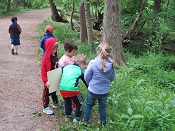
Thirty enthusiastic pre-school youngsters from two St. Luke’s Day School classes had their annual field trip to Dyke Marsh on April 29, 2019. Jennifer Gough, one of the teachers, reported, “We saw a snake, which the kids were thrilled about!” They were also excited to see the bald eagle in the nest along the Haul Road trail.
Raptors Enrapture 250 Fans

On April 20, 2019, 250 people of all ages, from babies in snugglies to seniors, were wowed by raptors at the annual Friends of Dyke Marsh (FODM) Raptor Rapture event in Belle Haven Park by the Potomac River.
Liz Dennison from Secret Garden Birds and Bees brought a barred owl (Strix varia), two Eastern screech owls (Megascops asio), a red-tailed hawk (Buteo jamaicensis) and a red-shouldered hawk (Buteo lineatus), birds that had been injured and cannot survive on their own.
FODMers Investigate the Habitat Quality of a Stream
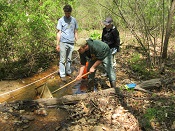
On a sunny April 16, 2019, for the third year, four FODMers helped conduct habitat quality testing in an unnamed stream flowing through Mount Vernon Park into west Dyke Marsh. This effort was led by Dan Schwartz, Ashley Palmer and Ben Rhoades of the Northern Virginia Soil and Water Conservation District (NVSWCD).
65 Clean Up Trash

On April 13, 2019, 65 enthusiastic volunteers of all ages tackled trash in Dyke Marsh and along the Potomac River shoreline, as part of the annual Ferguson Foundation trash cleanup. The Friends of Dyke Marsh had check-in stations at Belle Haven Park and at the Haul Road trail entrance. Among the volunteers were Boy Scout Troop 1107 from St. John’s Lutheran Church, a group of boys from Good Shepherd Catholic Church, Loyola University alumni, Notre Dame alumni and many other eager trash collectors.
Bald Eagles Are Star Attractions
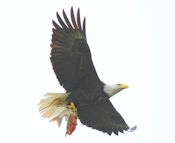
Many fans are stopping on the Haul Road trail to watch one of nature’s dramas – bald eagles (Haliaeetus leucocephalus) raising their young. On April 17, 2019, FODM former president Ed Eder photographed this adult bald eagle bringing a catfish to the nest. He wrote, “After depositing the fish at the nest, two eaglets were visible. One has contour feathers and is considerably larger. The other occasionally flaps and its wings are visible. The smaller one's head is still down covered.”


AlbertHerring-b4cc6b5cfb.jpg)



 Friends of Dyke Marsh, Inc. is a non-profit 501(c)(3) organization.
Friends of Dyke Marsh, Inc. is a non-profit 501(c)(3) organization.